Just back from one of my absolute favorite cities: Venice! With around 600 photos taken and more impressions than I can count, I'm sitting here wanting to write one post after another about this wonderful city.
And just as I'm about to start, I realize that I'm not entirely sure what exactly I should write about. After all, I recently published a blog post about Venice, describing my perfect day there. In it, I included everything I love so much about Venice.
So I spontaneously changed my mind and, after my sixth visit to the lagoon city, I will simply summarize the most important tips and hints for a great weekend there. I hope that this, together with my Perfect Travel Day report, will inspire you to take a spontaneous trip to Venice.
The top 7 tips for your trip to Venice
1. The best time to travel
I cannot emphasize it enough:
Off-season, off-season, off-season!
Everyone, even those who have never been to Venice, knows that the city is full of tourists. But if you haven't experienced it yourself, you can't imagine HOW crowded it is. No joke, honestly. Even outside of peak season, it's really busy, and the hotspots are always crowded during the day.
My absolute favorite months for traveling are March to mid-April and mid-October to early December. It's usually a lot warmer there than it is here, there are lots of tourists but not crowds, and accommodation is significantly cheaper than during Carnival, for example.
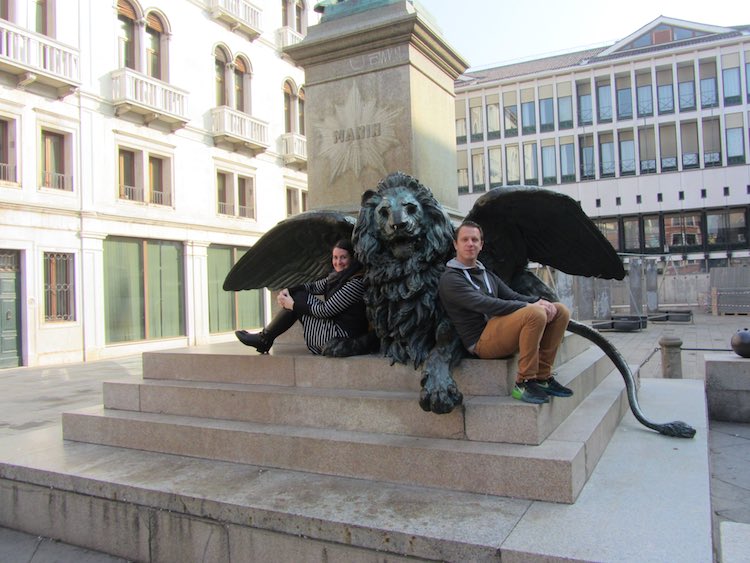
2. A stress-free journey
Venice is easily accessible by car, train or plane. Thanks to my proximity to Veneto from Austria, I have always travelled there by car. This has the great advantage that I always return home with half a boot full of Italian delicacies.
The more convenient option is to travel by train; there are direct connections from Vienna.
By car
Parking is not a problem, but rather a question of how much you are willing to pay. The most expensive car park is located at Piazzale Roma, right next to the train station, and costs over 30 euros per day. Somewhat cheaper, but still far from a bargain, is the car park at Tronchetto. To get there, you also drive over the long bridge, but turn right before entering Piazzale Roma (clearly signposted). There, too, you pay well over 20 euros per day.
From Tronchetto, take either the vaporetto (water bus) or the People Mover to Piazzale Roma.
However, both car parks can fill up quickly at weekends or during peak season. In that case, you will need to park outside the city, in Mestre. The rates there are not cheap either, but you can get away with paying between 10 and 16 euros per day. From there, it is a very quick train ride into Venice.
By train
From Austria, there are direct connections from Vienna to Venice by night train. The journey takes around 7 hours and is very affordable if you book early with ÖBB as a Sparschiene (saver) ticket.
When you get off at Santa Lucia station in Venice, you are already right in the middle of the city. Several vaporetto lines depart right outside the door. It is also easy to walk and well signposted. It takes around 20 minutes to walk to St. Mark's Square or the Rialto Bridge. However, if you are carrying heavy suitcases, it is better to take the vaporetto or a water taxi due to the many bridges.
In general, for anyone who wants to save money on vaporetto fares, a backpack is MUCH more practical than a suitcase for getting to the hotel.
By plane
Those arriving at Marco Polo Airport also find it quite easy to reach the lagoon: lines A and B take visitors directly to Fondamente Nove in the north or to St. Mark's Square.
3. Living in Venice itself or outside the city?
Have you seen all the amazingly cheap deals for a weekend in Venice? They all have one thing in common: you usually stay in Mestre. The location is not an issue. Trains run from Mestre to Santa Lucia station almost every few minutes, and there are also boats that make the crossing.
However, I am a big advocate of living right in the centre. Even if it means lugging your suitcase over 100 bridges and paying more, the feeling is simply completely different. Walking out the door in the morning and finding yourself in the middle of Venetian life instead of first trudging to the train station, waiting for the train, riding the train and only then ‘really’ arriving. An afternoon siesta is no problem, and if you get cold in the evening, you can just quickly grab a jacket. There's no need for stuffed daypacks with everything you might need.
And, of course, strolling through Venice at night, when it is almost deserted, after dinner is a real dream if you don't have to keep checking your watch to see when the next train is leaving.
However, one real advantage of staying outside Venice is that hotels in Mestre or on the Lido often offer free parking. So if you are travelling by car, this alone will save you a considerable amount of money.
Since 2024, there have been daily fees for visiting Venice on certain weekends (these do not apply if you have official accommodation in a hotel). Be sure to check in advance whether your visit will fall within these times, as there are checks (and penalties).
Day tickets must be purchased online in advance here: Venezia Unica
Venice is one of the hotspots in the heated debate about overtourism. Anyone who knows Venice knows why. That's why I would recommend booking official accommodation, such as a hotel or B&B. Why? AirBnB, and believe me, I'm actually a big fan of it, is contributing massively to the displacement of locals. Apartments can be rented to tourists at significantly higher prices than to residents, resulting in a loss of living space.
4. Public transport
Public transport in Venice is, of course, boats. The vaporetto mentioned above is the equivalent of our buses, and there are also private water taxis.
First things first: it's not cheap. However, when you consider that boats have completely different operating, repair and safety costs than motor vehicles, it's easy to see why. Single trips costing €7.50 (valid for 75 minutes) are still painful. Day and multi-day tickets are also available.

If you are not staying directly in Cannaregio (the district that begins at the train station) or near Piazzale Roma, you should at least pay for the journey to your accommodation. After that, Venice is simply a case of walking everywhere. First-time visitors in particular will mainly stay around central points such as Santa Lucia, the Rialto Bridge, St. Mark's Square and the Accademia in Dorsoduro. Even if you are on the move a lot (as is always the case on sightseeing weekends), the distances are not actually that far.
However, if you plan to visit the Arsenal or the Biennale, Murano, Burano and Giudecca, it might be worth buying a multi-day ticket. I recommend you simply calculate the cost.
If you like to treat yourself, I recommend a ride on a water taxi. There's hardly anything cooler than zooming through the Grand Canal and the smaller waterways in a chic motorboat like George Clooney & Co. It's best to ask the driver for the price to your desired destination upon arrival (or when you want to go) and not expect a bargain.
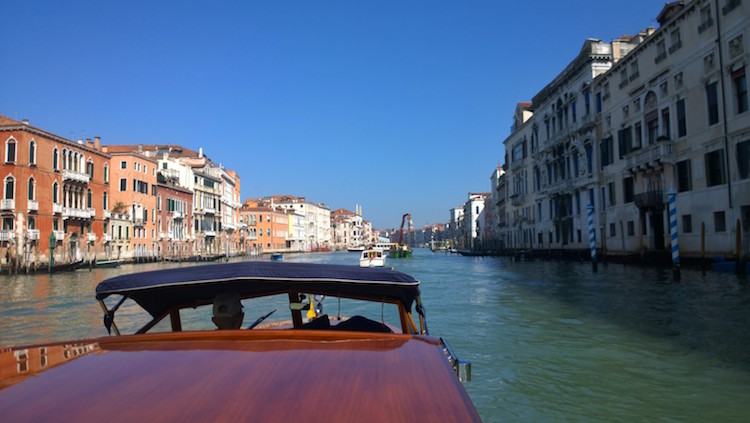
How do I find the vaporetto I need?
It's very simple: either use Google Maps to display the route by public transport, or read the lines departing from the respective station there.
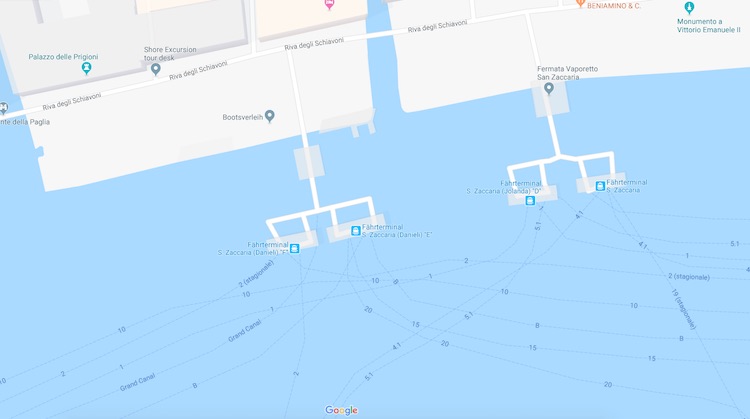
You can also find a route planner viewing platform and the departure times for all lines on the official website of the operator ACTV (the website is in Italian, but easy to navigate).
In addition, the stops for all lines departing from each station are indicated, and the ticket kiosks will be happy to provide you with information.
Where to buy tickets?
You can buy vaporetto tickets at the ticket kiosks at the stops, but these are usually only open between 8:00 a.m. and 8:00 p.m. and are not available everywhere. There are also ticket machines (which can be switched to English), or you can buy tickets at tobacconists.
All tickets must be validated at the round ticket validators before boarding the ferry.
5. Navigating through Venice
Anyone who considers themselves to have a natural sense of direction will quickly learn otherwise in Venice. I consider my sense of direction to be good. Definitely. My father, for example, is a master of orientation. If you leave him in the desert, as long as the sun is shining and he can use it for guidance, he will always find the nearest oasis. My brother... well, okay, I'm not going to talk about that here. (Sorry, Axel 😀 )
In any case, cities with rivers typically orient themselves along the course of the river. In Venice, this would be the Grand Canal. And this is where the issue arises: it has a sort of horizontal S-shape. Regardless of where one believes the canal to be located, it is certainly not there. In short, navigating there is not enjoyable.
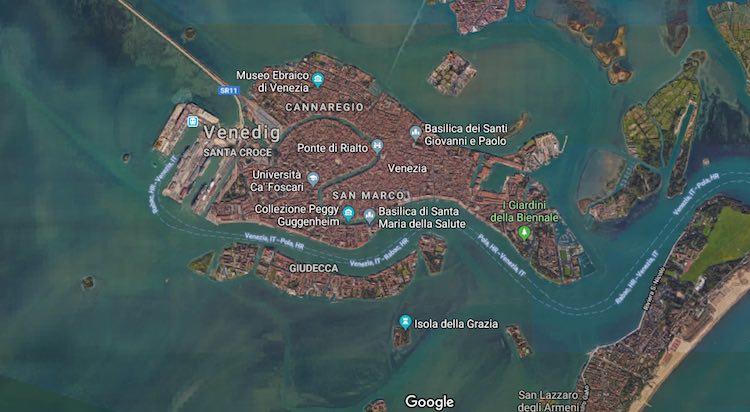
But thanks to smartphones and Google Maps, that's no longer a problem. Apart from the ongoing GPS issues due to the narrow streets, it works really well.
(We saw a man struggling with a large road map, which was somehow a funny retro experience...).
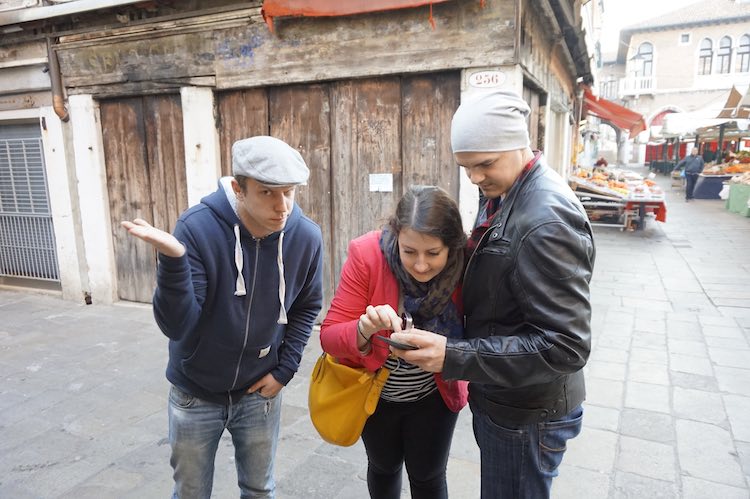
6. Eating and drinking in Venice
Venice is no different from other tourist cities. If you really want to drink an espresso at the famous Caffè Florian on St. Mark's Square, you're not only paying for the location, but also for the band that usually plays there. The same goes for the original Bellini at the famous Harry's Bar: almost 20 euros per glass is really no fun. Or maybe it is, if it's worth it to you! A little off the beaten track, however, things look very different.
Italian breakfast
Attention savoury breakfast lovers: Italians eat sweet breakfasts. They enjoy cappuccino and cornetto, which is a croissant, either plain or filled with apricot jam or chocolate (yum!). Sometimes you can also find a café with a wider selection of (sweet) delicacies.
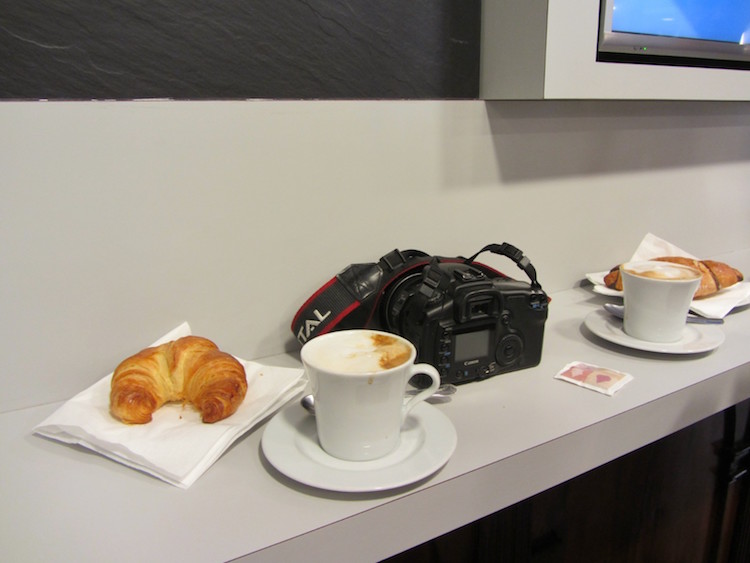
Those who need their ham sandwich or muesli in the morning will find it easiest as apartment dwellers. Hotels cater to all the desires of tourists anyway.
ATTENTION cappuccino drinkers: In Italy, cappuccino and latte macchiato are only drunk for breakfast. From late morning onwards, people switch to espresso (or simply called caffè) or macchiato (espresso with a dollop of milk foam). Of course, you can also be served a latte in the afternoon... but you'll get a disapproving look for free! 🙂
Cicchetti, and why you don't really need restaurants in Venice
Venedig hat, und ich LIEBE es, eine ausgesprochen sympathische und fröhliche Trinkkultur. Um 11 Uhr Vormittag das erste Glaserl Wein oder einen Aperol Spritz zu zischen gilt hier keineswegs als versteckter Alkoholismus. Natürlich braucht es dafür aber eine gewisse Unterlage, und die bieten alle Bars (bàcari) in Form von Cicchetti, also kleinen pikanten Naschereien. Belegte Brötchen, frittiertes Gemüse, Fisch – jede Bar hat etwas anderes anzubieten. Und mit ein paar Cicchetti im Magen trinkt sich das zweite Glaserl auch viel leichter.
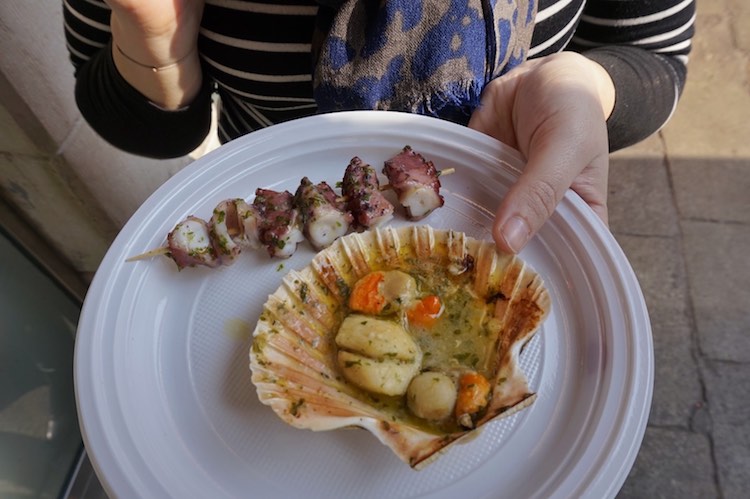
Incidentally, cicchetti are available around the clock in the bàcari. So if you want to save money, just fill up there; it's usually cheaper than eating at a restaurant. And it's more varied, too. Who needs a salad?
Incidentally, some bàcari also offer primi piatti, i.e. dishes such as pasta or risotto, which are sometimes cheaper than in restaurants.
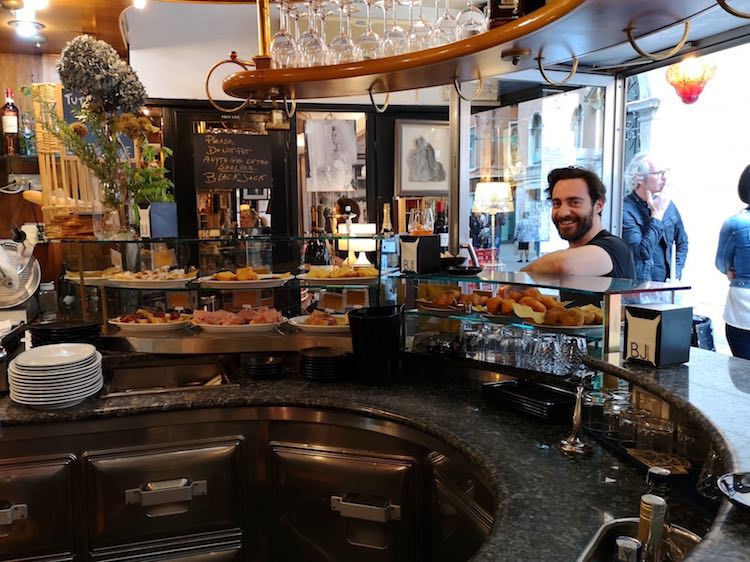
Bibamus!
Let us drink! But what exactly?
Red wine, white wine, frizzante or beer are available everywhere. There is something for every taste. Bars also have a wider selection of stronger alcoholic beverages, cocktails or various aperitifs.

Of course, you can't go past the typical spritz, either with Aperol or Campari, always with Prosecco, soda, a slice of orange and an olive. In Italy, they don't pour the Aperol over the rim of the glass like we do, but pour it straight in. With Aperol, things get pretty lavish after the second glass (which brings us back to the topic of cicchetti).
Ob Aperol oder Campari ist übrigens Geschmackssache. Mich schüttelt es ja beim Thema Campari, brrr. Ich habe mal gehört, dass Campari Spritz eher der Männerdrink ist, und Aperol Spritz der für Damen, konnte das aber bei meinen Italienbesuchen noch nie so wirklich verifizieren.
By the way, the snacks served with the glass (nuts, crisps, etc.) are free of charge. Thanks to the salty snacks, you drink more.
Don't sit down!
A genuine money-saving tip that can make a significant difference: there is always a price difference between drinking your Aperol Spritz or coffee at the bar (al banco) or being served at your table. An espresso at the bar usually costs €1.50, but served at your table it can easily cost twice as much. Of course, you can use the bar stools, and in the bàcari you can also sit down (if it's self-service).
I discovered the most striking price difference at Campo dell'Erbe: a gin and tonic served at the table cost three times as much – and that's not exactly cheap, considering the base price is 8 euros.
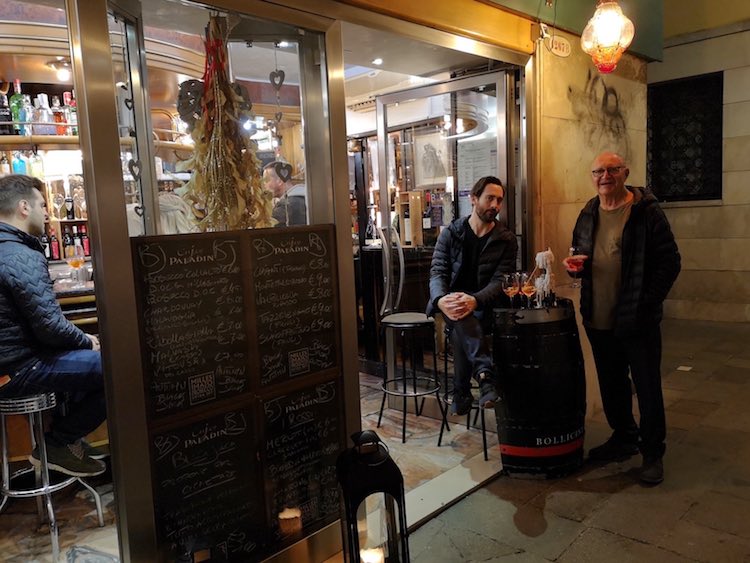
7. Sights
These are the top 3 sights in the lagoon city that you simply cannot miss:
Piazza San Marco
One of the most famous squares in the world, with its magnificent basilica, slightly leaning campanile and fantastic view out over the lagoon. A gathering place for all tourists. It is best to visit early in the morning or late in the evening, when the day tourists are not yet there or have already left.
By the way: you shouldn't walk between the two columns at the beginning of St. Mark's Square by the water, because it brings bad luck: executions used to take place there. Superstition alert!
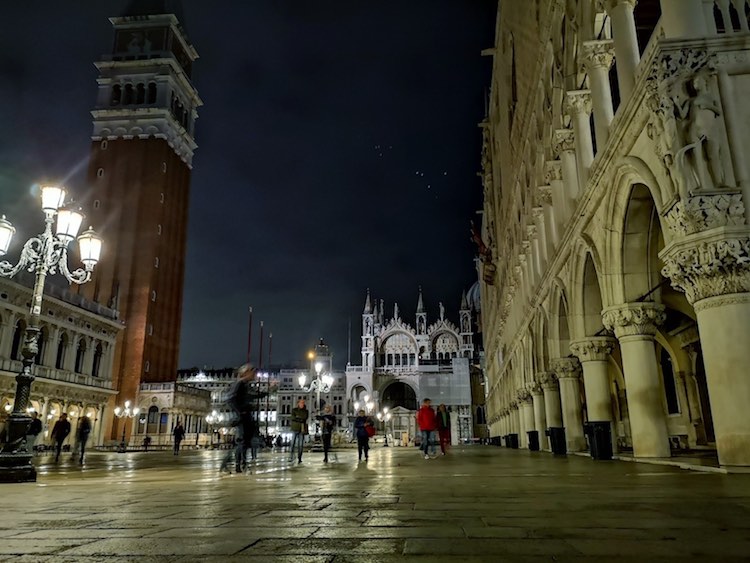
Ponte dei Sospiri
The Bridge of Sighs is not a ‘real’ bridge but a connection between the Doge's Palace and the former prison. It got its romantic name because prisoners on their way to prison could supposedly take one last sighing glance at freedom from there.
The Bridge of Sighs from behind
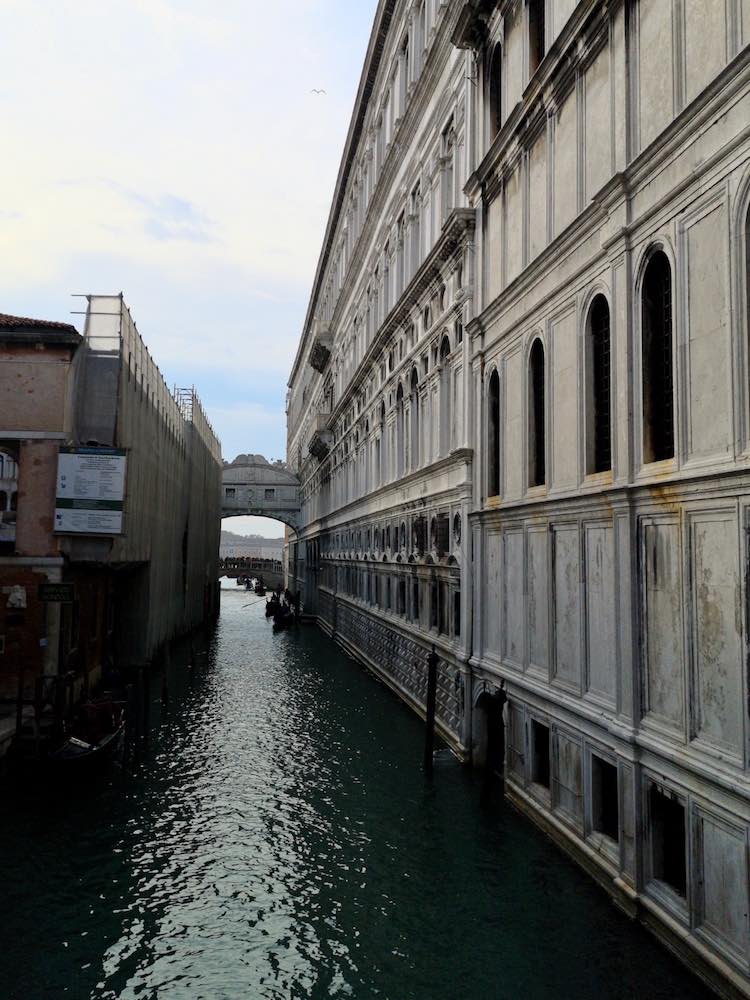
Ponte di Rialto
In my opinion, the most famous bridge in the world has gained something again since the dark blinds were repainted and the countless graffiti and tags were removed. However, I'm not so keen on the fact that tourist junk is sold in several shops on the bridge. But the Rialto Bridge is the Rialto Bridge, and you have to see it. Apart from that, it is the only bridge over the Grand Canal in the city centre, which means that you have to cross it again and again during every visit to Venice.
The same applies here: late in the evening, it is not only at its most beautiful, but also not quite as deadly crowded.
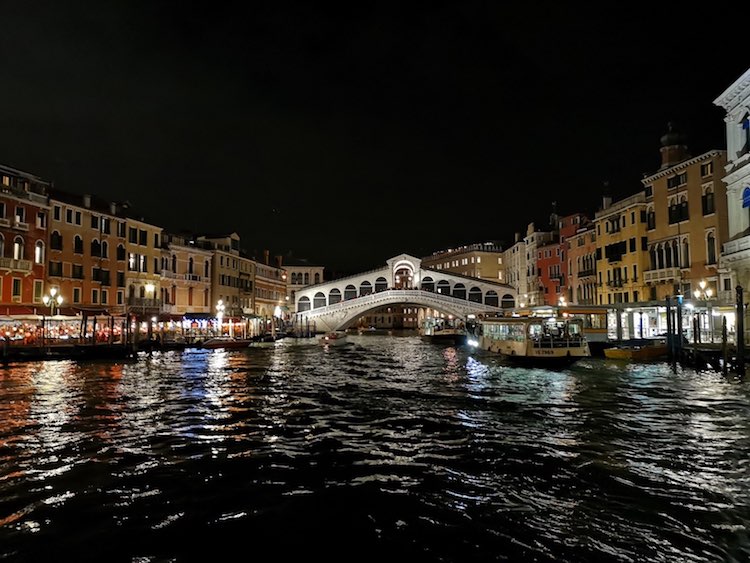
There are, of course, plenty of sights to see in Venice. And you know that I'm not a fan of visiting museums, so I won't even start on that. What I would recommend, however, is to walk through the lagoon city with your eyes wide open and discover the many hidden gems. Charming little bridges, narrow alleys, squares that have been spared from the tourist crowds, courtyards, lions on every corner and so on. Photographers will find their Mecca here, and for Instagrammers: it's SO Instagrammable!
I wish you a wonderful time in Venice. Drink Aperol Spritz, eat cicchetti and, above all, ENJOY your time there instead of rushing from one sight to the next! La vita e bella in Venezia.


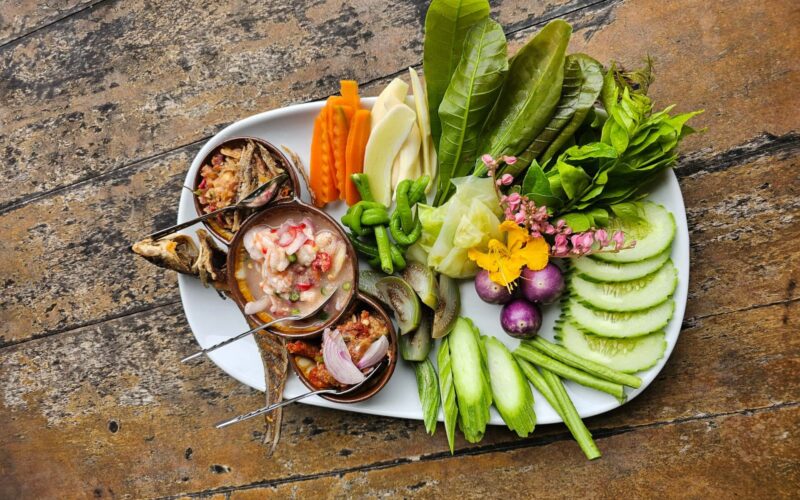
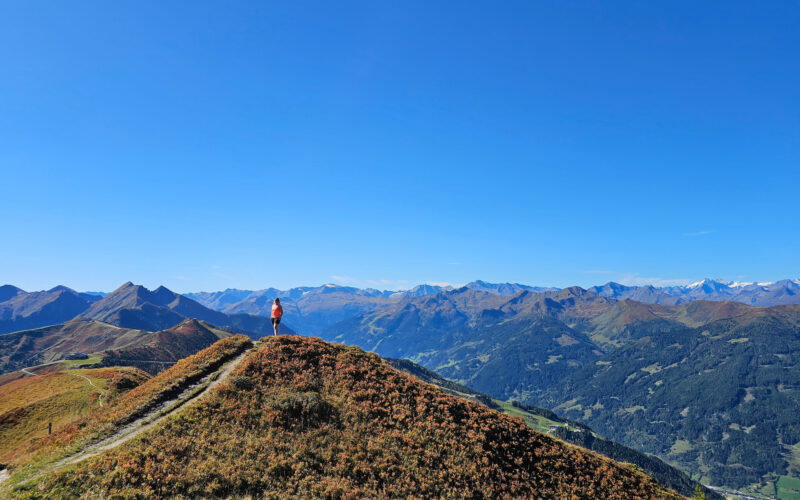

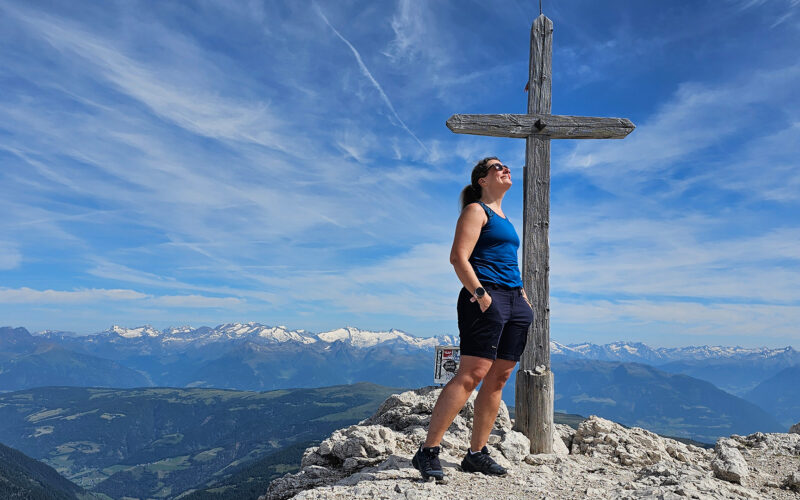
Mit diesem Artikel auf Venedig hast du mir gerade sehr viel Lust gemacht, bald mal wieder dort hinzureisen, liebe Martina. Meine zwei Besuche in der Stadt liegen gefühlt schon ewig zurück. Mal schauen, ob wir es in der Off-Season einrichten können. Denn das wäre einfach perfekt.
Liebe Grüße aus Berlin
Martina
Ja Venedig ist doch einfach wunderbar! 🙂 Und die Off-Season zahlt sich echt aus, sowohl in der Menschenmasse, die dort ist, als auch im Unterkunftspreis. Ich freu mich, wenn ich bei dir auch von Venedig lesen darf 🙂
Liebe Grüße,
Martina